In previous butterfly articles, we discussed a lot of butterflies with different colors. In this post, we will discuss some of these amazing creatures, i.e., the purple butterfly.
These butterflies evolved in such a way that they get purple coloration on their wings, which helps them better survive in nature. They are beautiful yet fascinating, and they have many secrets to reveal.
I will introduce you to these remarkable creatures and some interesting facts about them in this article. Here is a list of 15 types of purple butterflies found in nature, so let’s get started.
What is the spiritual meaning of the purple butterfly?
The spiritual meaning of purple butterflies depends on different cultures. In general, purple represents creativity, royalty, femininity, and spirituality. But in some cultures, it symbolizes love, magic, and good luck.
If you see a purple butterfly, it reflects your spiritual journey as well. It can be a sign of new change and chance, or it can show you a new path of enlightenment.
Must Read: 50 Beautiful Black, Red, Blue, Purple & Pink Butterfly On Earth
18 Types of Purple Butterfly
1. Dingy Purple wing
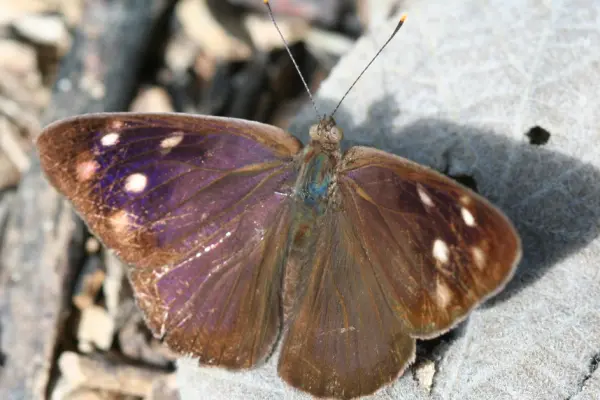
| Scientific name | Eunica monima |
| Size | 1 to 2 inches wingspan |
| Identification | Blue wings with purple and brown margins. |
| Geographical location | West Indies, Mexico, and South America |
Dingy purple wing or Florida purple wing are common names for this dazzling Eunica monima.
Commonly found in the West Indies, Mexico, and South America. They show sexual dimorphism, females show brownish coloration on forewings, and males’ forewings are brown with purple margins.
Their wings have characteristic white spots, which are six in number in both sexes and somewhat blurry in females compared to males. They are small butterflies with a wingspan of 1 to 2 inches.
2. Purple mort bleu
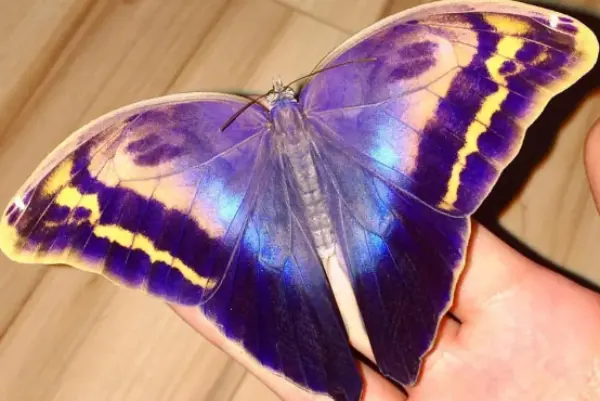
| Scientific name | Eryphanis polyxena |
| Size | 4 to 5-inch wingspan |
| Identification | Have purplish wings with black brown markings |
| Geographical location | Central and South America |
Morphinae subfamily member purple mort bleu is a close relative of owl butterflies. They have the same eyespots on their ventral wings, just like them.
Like the owl butterflies, they open their wings rarely, and when they do, one can get a view of beautiful purplish blue wings with broad black markings. They are medium-sized, with an average wingspan of 4 to 5 inches. They mostly feed on fallen fruits on the ground and flower nectar.
3. Purple beak
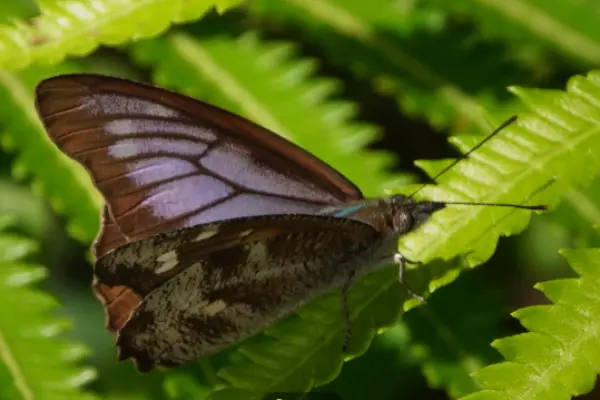
| Scientific name | Libythea geoffroy |
| Size | 5 cm wingspan |
| Identification | males have purple wings with brown veins. |
| Geographical location | Southeast Asia |
Another species on the purple butterfly list is the purple beak butterfly. One can find these beautiful butterflies in Southeast Asia, including India, Myanmar, Thailand, Malaysia, Taiwan, and the Philippines.
They are medium-sized and have an average wingspan of 5 cm. Males are totally different from females. Males have purple wings with dark brown wings, whereas females are brown and don’t show any purple nuances. They primarily prefer fallen fruits to feed on.
4. Powdered oak blue
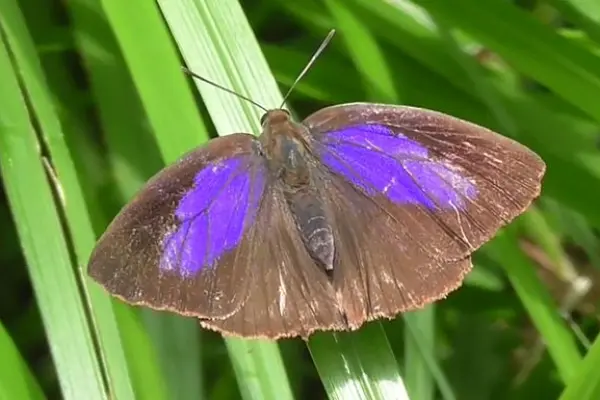
| Scientific name | Arhopala bazalus |
| Size | 2 to 3 inches of wingspan |
| Identification | Have brown and purple sections on their forewings |
| Geographical location | Myanmar, China, India, Japan, Philippines, and Taiwan |
Arhopala bazalus, or powdered oak blue, is native to Myanmar, China, India, Japan, the Philippines, and Taiwan. These butterflies show remarkable bands of purple and brown colors. Both males and females show purple coloration, unlike the above butterfly species.
Purple bands in females are much paler than in males. These evergreen forests’ inhabitants mostly prefer oak species. They often mimic dead leaves because of the dark brown nuances on their wings.
5. Great purple emperor
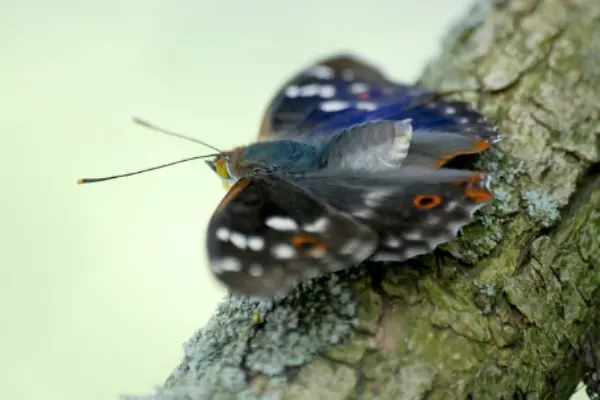
| Scientific name | Sasakia charonda |
| Size | 2.6 inches of wingspan |
| Identification | Have purplish wings with white spots |
| Geographical location | Japan, China, the Korean peninsula, Taiwan, and Vietnam |
This incredibly great purple emperor is the national butterfly of Japan. As their name suggests, they are large, with a wingspan of 2.6 inches. It is commonly found in Japan, China, the Korean Peninsula, Taiwan, and Vietnam, inhabiting woods or beechwood forests from lowlands to low elevations.
They have bluish-purple wings with white and yellow spots all over them and brown margins. Talking about their diet, they mostly prefer honeydew from aphids and tree saps.
6. Indian purple emperor
| Scientific name | Mimathyma ambica |
| Size | 50 to 60 mm of wingspan |
| Identification | Have black wings with white and blue bands |
| Geographical location | Asia |
Mimathyma ambica, commonly known as the Indian Purple Emperor, is a nymphalid butterfly in Asia. This Indian-originated species was popularized by Victorians and is now found all across the world.
These butterflies have almost black wings with white spots and bands. They have bluish-purple bands on their hindwings, which make them attractive.
They occur in many color forms in different regions. With an average wingspan of 50 to 60 cm, these butterflies have a special place in Indian biodiversity.
7. Purple owl butterfly
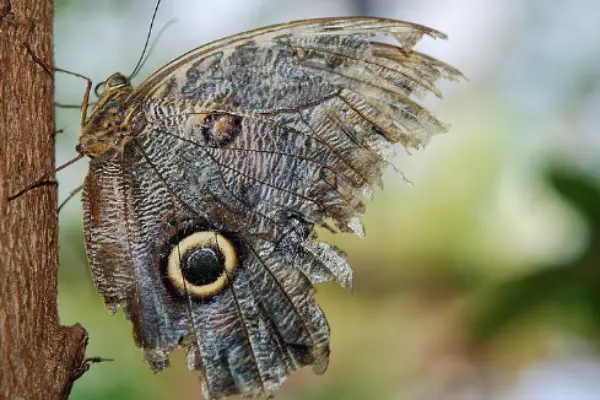
| Scientific name | Caligo beltrao |
| Size | 120mm of wingspan |
| identification | Purplish-blue wings with orange tips |
| Geographical location | Brazil |
Now we have purple owl butterflies on this list. This butterfly consists of many colors, like yellow, brown, blue, and purple. The purple owl butterfly is one of the largest butterflies in the world, with an average wingspan of 120 mm.
Like their color, they primarily feed on purple arrowroot flowers. These butterflies are mostly purplish-blue with brown underparts and remarkable orangish-yellow tips.
8. Purple-washed-eyed metalwork

| Scientific name | Mesosemia lamachus |
| Size | No information |
| Identification | have purplish-blue eyespots with yellow lining |
| Geographical location | Central and South American |
Mesosemia lamachus, or purple washed-eyed metal mark, is a species of butterfly belonging to the family Riodinidae. These Central and South American butterflies mostly prefer tropical and neo-tropical climates.
They have remarkable purplish blue eyespots that are lined with yellow. Apart from that, their forewings are brown, whereas their hindwings are purplish-blue.
9. Agathina emperor
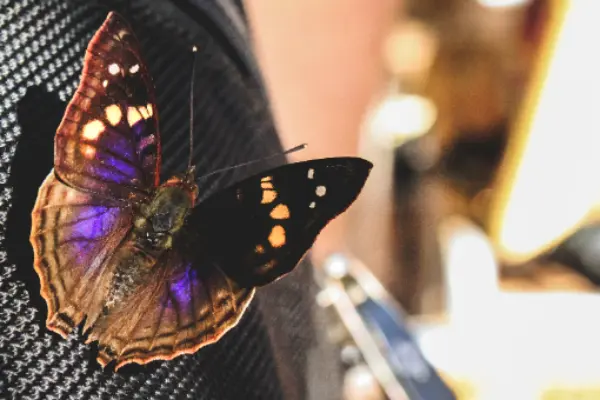
| Scientific name | Doxocopa agathina |
| Size | 2 inches of wingspan |
| Identification | Males have purplish wings with orange spots |
| Geographical location | Brazil and Amazon region |
Agathina Emperor has sexual dimorphism. Males have purple wings with orange spots, whereas females are brown with dark orange bands. They are medium-sized and have a wingspan of 2 inches.
One can easily find these species in Brazil and the Amazon region. They mostly feed on animals, rotting matter, and plants.
10. Queen purple tip
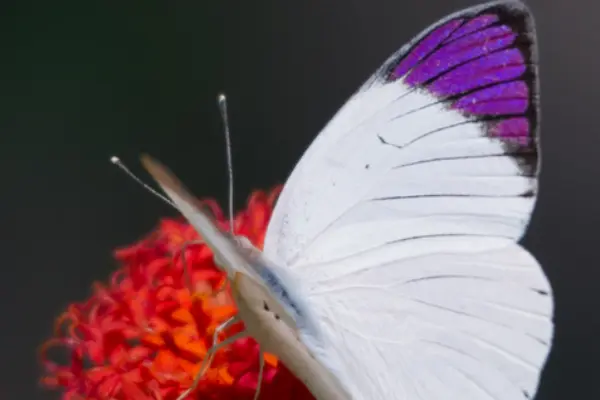
| Scientific name | Colotis regina |
| Size | 45 to 62 mm |
| Identification | White wings with purple tip |
| Geographical location | Afrotropical realm |
You must have seen or heard of the orange-yellow tip, but have you ever heard of the queen-purple tip? The Queen Purple Tip Butterfly is a beautiful purple and white butterfly. Their unique yet distinctive appearance makes them the most beautiful butterflies in the world.
With a wingspan of 45 to 62 mm, they are small with white wings and purple tips. This Pieridae family member is commonly found in the Afrotropical realm.
11. Pansy dagger wing
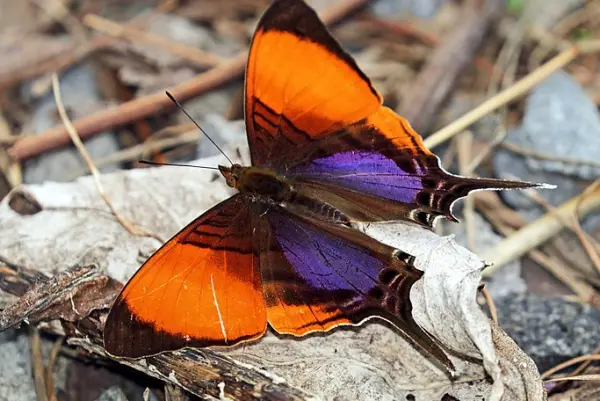
| Scientific name | Marpesia marcella |
| Size | 5 to 6 cms of wingspan |
| Identification | Have orange and purple bands on fore and hindwings, respectively |
| Geographical location | Guatemala, Costa Rica, Panama, Ecuador, Colombia, and Peru |
Pansies are known for their unique and beautiful appearances. This pansy dagger-wing butterfly is multicolored with orange, purple, and brown coloration.
They are commonly found in Central and South America, from Guatemala to Peru. Their forewings have orange bands, and their hindwings have beautiful purple coloration.
A short brown tail arises from their hindwings. As their name indicates, they mainly feed on flowers like pansies, violets, etc.
12. Colorado hairstreak
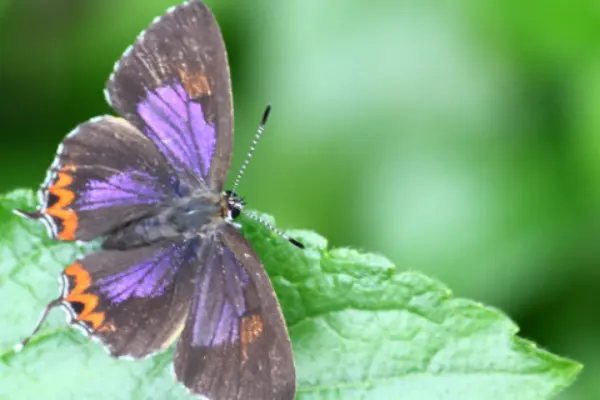
| Scientific name | Hypaurotis crysalus |
| Size | 3.1 to 3.8 cm of wingspan |
| Identification | Have dark purple wings with orange spots on margins |
| Geographical location | Utah, Colorado, Arizona, New Mexico, and the Colorado Plateau states |
The Colorado hairstreak is named after Colorado State and is commonly found in the southern United States and Mexico. They have dark purple wings with broad black bands.
Each wing has orange spots on its margins. These small butterflies with wingspans ranging from 3.1 to 3.8 cm mostly prefer honeydew, sap, and sugary secretions from oak galls. This Colorado state insect mostly inhabits oak scrublands.
13. Malayan Assyrian
| Scientific name | Terinos clarissa |
| Size | 3 to 4 inches of wingspan |
| Identification | Have black and purple coloration on the uppersides |
| Geographical location | Southeast Asia |
Terinos clarissa, or Malayan Assyrian, is a beautiful butterfly of the family Nymphalidae. These butterflies are mostly purple-black with yellow hindwings, but some rare morphs have beautiful purple coloration on both their hind and forewings.
Their ventral brown wings often resemble dry leaves and have brown spots. Their dorsal sides have remarkable black-purple coloration, which stands them out in the crowd. medium-sized with a wingspan of 3 to 4 inches.
14. Lesser purple emperor
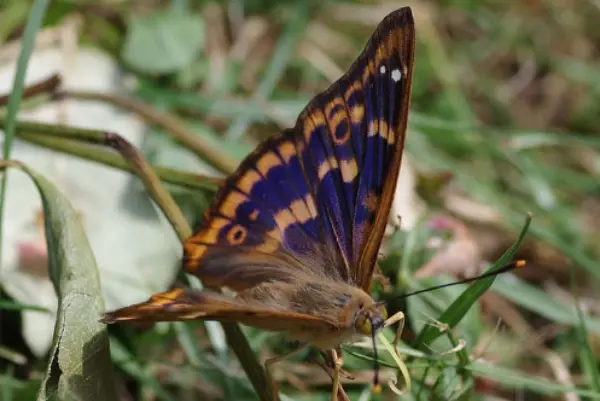
| Scientific name | Apatura ilia |
| Size | 2.2 to 2.8 inches of wingspan |
| Identification | Have purple wings with orange bands |
| Geographical location | North Spain, France, Central Europe, and Northern Greece |
Lesser purple emperor is a beautiful and rare butterfly found in North Spain, France, Central Europe, and Northern Greece. The females are comparatively larger than the males; females have a wingspan of 60 to 70 mm, and males have 55 to 60 mm.
A distinctive purple iridescence is present on its upper wings. Males are more beautiful than females, with metallic violet-blue coloration, whereas females are brown with white markings. They mostly feed on nectar, tree sap, and honeydew.
15. Glazed pellicia
| Scientific name | Pellicia arina |
| Size | 1 to 1.5 inches of wingspan |
| identification | Have iridescent blue green shade |
| Geographical location | Central America and Mexico |
Glazed pellicia, or Pellicia arina, is commonly found in tropical regions of Central America and Mexico. They got their name from the glazed pellicia because of their distinctive pattern of iridescent blue and green scales on their wings.
Also, you can see dark-purple shades all over its body. They just give the purple color when the light strikes their wings.
These butterflies are small, with a wingspan of 1 to 1.5 inches, and can be seen flying in March and April. These forest edges and trails inhabit species that mostly prefer flower nectar.
16. Northern pearly eye
| Scientific name | Lethe anthedon |
| Size | 4.5 – 6.7 cm |
| identification | Have dark eyespots on the upper side of the wing |
| Geographical location | North America, from central Saskatchewan and eastern Nebraska east to Nova Scotia, south to central Alabama and Mississippi |
17. Purple crow butterfly
| Scientific name | Euploea tulliolus |
| Size | 4 to 8 cm |
| Identification | Have white spots on the edges of their forewing |
| Geographical location | Solomon Islands, Malaysia, Taiwan, Vietnam, Singapore, and Australia |
As you can see in this picture, the purple crow butterfly is a beautiful butterfly species with bluish-purple wings with brown margins and white spots on their edges, which just makes them more admirable.
They are commonly found in the Solomon Islands, Malaysia, Taiwan, Vietnam, Singapore, and Australia.
They show migration from the north to the south.
These butterflies have the ability to produce sound by using their wings.
18. Freyer’s purple emperor
| Scientific name | Apatura metis |
| Size | Up to 32 mm |
| identification | Have purple wings with orangish yellow bands |
| Geographical location | Eurasia, Southeastern Europe, Southwestern Siberia, South-European Russia, Japan, Korea, Northeastern China |
Due to their similar appearances, people frequently confuse Freyer’s purple emperor for a lesser purple emperor.
The upper side of the wings is allured with distinctive iridescent purplish blue coloration with orangish yellow bands over it, just adding cherry on top.
Primarily, they are found near rivers and streams, feeding on willow species. Due to their small population size, they are protected in Europe.
Conclusion
Here we conclude our article on 18 types of purple butterflies found in nature. You must have gained knowledge about these amazing creatures. I hope you like this article. We will be back with another butterfly article soon; till then, enjoy this.
Also Read:

Being a zoology student I’m always been fascinated toward animals especially insects. I love to do research and learn about different animals. As a writer I want to share my thoughts about nature through my articles. Apart from this you can find me exploring the new places and voice notes.

